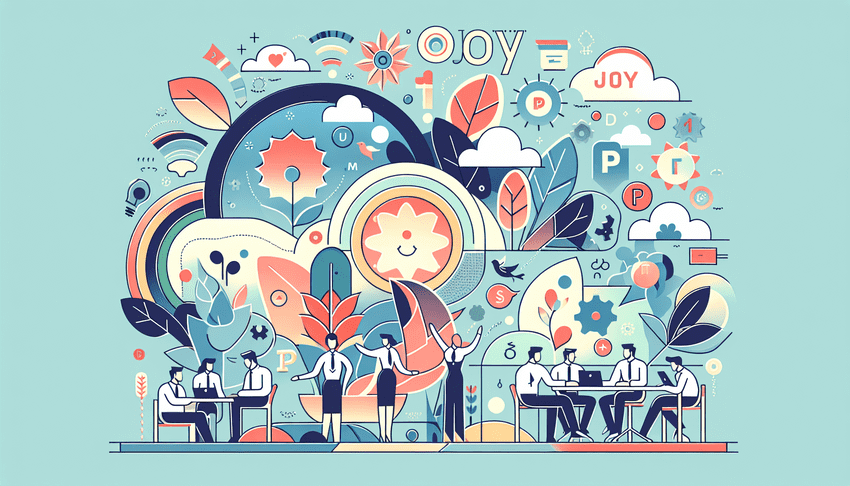Table of Contents
Cultivating Positive Workplace Culture

Fostering Social Connections
Understanding the link between social connections and Workplace Happiness is an essential component of Positive Psychology. Increased camaraderie and effective communication within a company are significant predictors of job satisfaction and can lead to a harmonious and productive work environment.
Social Bonds: More Than Just Being Friendly
Humans are inherently social beings, and the workplace is no exception when it comes to the need for interaction and connection. Research has shown that social connections at work can reduce stress, foster a sense of belonging, and bolster individual and team performance.
- Creating a culture of openness: It starts with leadership. Management that encourages openness, values interpersonal relations, and promotes work-life balance sets the stage for stronger connections.
- Team-building activities: These can range from simple ice-breaker exercises to complex retreats designed to enhance trust and understanding among employees. The goal is to break down barriers and encourage collaboration.
- Mentorship programs: Pairing new or less experienced workers with mentors can accelerate learning and create bonds that contribute to workplace satisfaction.
Communication: The Foundation of Connection
Facilitating clear and open channels of communication is paramount in forming and maintaining social connections. When communication flows freely, employees are more likely to feel heard and valued, which fosters happiness at work.
- Regular check-ins: These can offer both parties the opportunity to share feedback and address any concerns before they escalate.
- Effective team meetings: Structured meetings with clear objectives can help ensure everyone’s on the same page. It’s vital that these meetings also allow for open discussion to encourage participation and engagement.
- Training on interpersonal skills: Workshops that focus on communication, conflict resolution, and emotional intelligence can empower employees to interact more effectively with each other.
Real-world Impact of Nurtured Relationships
Concrete examples demonstrate the power of social connections in boosting Workplace Happiness. Google’s Project Aristotle, which studied hundreds of its teams, found that the best teams were those where members felt safe, connected, and able to speak up. Another example can be seen in how the SAS Institute implemented ‘Random Coffee Talks,’ pairing employees from different departments to meet and chat, leading to increased interdepartmental understanding and collaboration.
While strategies to boost social connections are varied, the underlying principle remains the same: a workplace that provides opportunities for its employees to build strong interpersonal relationships is one that aligns with the principles of Positive Psychology and fosters an environment of Workplace Happiness. The result is not just a happier workforce but also a more effective, innovative, and dynamic organization.
Fostering Optimism and Resilience
In the rapidly evolving landscape of modern workplaces, the infusion of Workplace Positive Psychology has become an imperative for fostering Employee Happiness and cultivating a Productive Work Environment. Central to this pursuit is the concept of optimism, a driving force that equips individuals with a positive expectation towards future outcomes. Optimism is not a mere wishful thinking; it’s a psychological attribute linked to numerous benefits, such as better health, higher performance, and greater persistence.
Optimism alone is not enough for enduring the slings and arrows of corporate life. It must be coupled with resilience—the capacity to recover quickly from difficulties. Resilience transforms potential adversities into learning opportunities, enabling individuals to thrive amidst challenges. Together, optimism and resilience constitute foundational pillars for an Organizational Well-being and a Positive Work Culture.
Evidence-Based Strategies for Cultivating Optimism and Resilience
There are numerous strategies to nurture these crucial traits among employees. Practical applications such as resilience training programs have shown promising results in enhancing workplace atmosphere. Reflective practices like journaling positive experiences and gratitude exercises can shift employees’ focus from negativity to a more appreciative and resilient mindset.
- Implementation of resilience training emphasizes practical coping mechanisms to handle workplace stress. For instance, the use of cognitive-behavioral techniques to reframe negative thought patterns into more constructive ones.
- Mindfulness sessions contribute to a calm and focused workplace, which can mitigate the effects of stress and aid in the cultivation of resilience.
- Positive relationship building through team activities and peer support networks can create an environment rich in emotional buffers, thus promoting resilience.
Real-World Success Stories
The argument for fostering a Resilient and Optimistic workplace culture is further bolstered by successful organizational case studies. Companies such as Google have prioritized employee psychological health by implementing programs like ‘Search Inside Yourself’, which combine mindfulness and Emotional Intelligence training. The results speak for themselves: employees report increased well-being, productivity, and job satisfaction.
Another example includes Aetna’s mindfulness and stress-reduction programs, which have not only improved employee health but have also saved the company millions in healthcare costs. These tangible outcomes highlight the effectiveness of Positive Psychology interventions in creating a more healthful and productive work environment.
Employing these strategies can ultimately lead to a workplace characterized by resilient and optimistic employees, where challenges are met with creativity and courage. Organizations that prioritize these aspects of Positive Psychology demonstrate a clear understanding of the fundamental human needs that drive satisfaction and high performance. Investing in such programs is not only ethically sound but also commercially astute, paving the way for enhanced well-being and success.
Personal Development and Resilience in the Workplace

Building Emotional Intelligence
Workplace Happiness, a term that often echoes around the corners of modern offices, has become a crucial factor in today’s fast-paced work environments. A key ingredient to fostering an atmosphere of job satisfaction and productivity lies in the development of Emotional Intelligence (EI) among employees. Building Emotional Intelligence
Emotional Intelligence is the ability to understand and manage one’s own emotions and to be attuned to the emotions of others. In the context of workplace stress, EI plays an indispensable role in how employees respond to pressure, handle conflicts, and maintain a positive work atmosphere. Rather than succumbing to the throes of stress, individuals with high EI are adept at de-escalating tense situations, making them invaluable in any professional setting.
Consider the case of a high-pressure project deadline. An employee with strong Emotional Intelligence might recognize the signs of mounting stress within the team, address it openly, and suggest a collective break or a quick stress-relief activity. This not only diffuses tension but also strengthens team cohesion, thereby enhancing Workplace Happiness.
Furthermore, effective communication lies at the heart of professional relationships, and here too, Emotional Intelligence is paramount. Individuals who can empathize with their colleagues are better poised to navigate workplace dynamics gracefully. They listen actively, provide constructive feedback, and foster an environment where diverse opinions are valued and conflicts are resolved with respect and understanding.
Training in Emotional Intelligence can notably increase empathy among employees. For instance, role-playing exercises during EI workshops can help team members step into each other’s shoes, leading to greater understanding and mutual respect. Such training also provides tools to manage emotional responses, which is especially beneficial in customer-facing roles where one must maintain composure and professionalism at all times.
Leadership is another realm where Emotional Intelligence has a profound impact. Leaders with high EI are not just managers; they are visionaries who inspire trust and loyalty. They are keenly aware of their team’s morale and work diligently to ensure a supportive atmosphere that nurtures growth and happiness. Their leadership style is not about command and control, but about empowerment and collaboration.
To illustrate, a leader might notice a team member showing signs of burnout. Instead of ignoring the issue, an emotionally intelligent leader would engage in a one-on-one discussion to understand the employee’s concerns and collaboratively formulate a plan to alleviate the stress, thereby contributing to Workplace Happiness.
Emotional Intelligence training programs can sculpt empathetic and emotionally savvy leaders. These programs might include self-reflection exercises, mindfulness training, and learning how to give and receive feedback effectively, all of which are valuable leadership skills.
In conclusion, it is clear that Emotional Intelligence is not just a soft skill—it is a critical asset in any professional’s toolkit. It equips individuals to deal with the complexities of work life, including stress management and the navigation of professional relationships. By prioritizing EI in personal development and corporate training strategies, organizations can pave the way for enhanced Workplace Happiness, resulting in a healthier work environment, increased employee engagement, and ultimately, higher success and productivity.
Promoting Mindfulness Practices
Workplace Happiness is not merely a buzzword; it is a validated phenomenon that can have a profound impact on an organization’s success. The adoption of mindfulness practices within the workplace is one of the key strategies to enhance well-being, reduce stress, and cultivate a positive work environment.
- Reduced Stress: Mindfulness practices like meditation have been scientifically shown to decrease stress levels. By allowing employees to engage in short meditation sessions during the workday, organizations can promote a calmer, more composed atmosphere.
- Improved Focus and Clarity: Regular mindfulness exercises can sharpen focus and clear mental clutter, contributing to more efficient decision-making and problem-solving.
- Enhanced Emotional Intelligence (E): Mindfulness bolsters Emotionale Intelligenz, enabling employees to better manage their emotions and empathize with colleagues, leading to more harmonious workplace relationships.
Integrating Mindfulness into the Corporate Routine
Introducing mindfulness to a corporate setting requires both a strategic approach and an openness to cultural shifts. Here are practical steps organizations can take:
- Scheduling Quiet Time: Companies can allocate specific times for mindfulness activities, such as starting the day with a group meditation session or providing quiet rooms for individual practice.
- Providing Resources: Employers can offer access to mindfulness apps, or bring in a mindfulness coach to facilitate workshops and provide guidance.
- Encouraging Breaks: Promoting regular breaks is crucial for employees to reset and practice mindful breathing or a brief meditation, assisting in maintaining their focus and preventing burnout.
Real-World Application and Success Stories
Consider the case of a high-stress software development firm that incorporated a ‘Mindfulness at Work‘ program. After three months, the company not only reported a drop in stress-related absenteeism but also observed an uptick in productivity levels. Employees reported feeling happier, more connected to their work, and more collaborative with their peers.
Mindfulness, therefore, is not just an individual concern; it is a practical investment in Workplace Happiness. Embracing these practices can transform the work environment, leading to a more content and productive workforce. Companies that understand and implement these methods are setting themselves apart, heralding a future where Workplace Happiness is the norm, not the exception.
Summary
Imagine stepping into an office where the air buzzes with positivity, where every employee feels genuinely connected, contributing to a vibrant symphony of productivity. This isn’t a mere fantasy; it’s the potential reality of a workplace infused with the principles of Positive Psychology, focusing on the transformative power of social connections and happiness.
- Human Connections at the Heart of Workplace Thrive: It’s about more than just sharing a coffee or chatting about the weekend — it’s about cultivating an environment where every interaction adds a brick to the foundation of a more cohesive and joyful workplace. Open communication, mentorship, and team-building aren’t just items on a checklist; they’re pathways to fostering meaningful relationships that amp up our satisfaction at work.
- Communication: The Lifeline of Positive Relations: Like a well-oiled machine, clear and open dialogue ensures all parts of the organization are moving in harmony. Regular check-ins, effective meetings, and interpersonal skills workshops are more than just mechanisms for sharing information; they’re opportunities for individuals to feel heard, seen, and valued.
Stories of Success: The Practical Magic of Connection
Tales from giants like Google, with their Project Aristotle, to initiatives such as the SAS Institute’s ‘Random Coffee Talks’ aren’t just heartwarming anecdotes. They serve as proof of concept that when we nurture the soil of social connections, the fruits are a happier, more productive workforce and a thriving company culture.
Beyond initiatives, shifting our focus to the strengths of our organizations through Appreciative Inquiry (AI) magnifies our potential for workplace happiness. AI’s 4-D cycle invites us to dream big, design boldly, and create our destiny with the positive as our guiding star. Empirical evidence from case studies demonstrates time and again that when organizations plant seeds of positivity, they harvest the rewards of heightened spirits and success.
In our fast-paced world, Emotional Intelligence (EI) has emerged as a cornerstone for personal and professional growth. Picture a team member adept in EI, weaving through the complexities of workplace relationships with the finesse of a seasoned diplomat, turning potential conflicts into opportunities for bonding. The result? A resilient workforce armoured against the everyday battles of stress and miscommunication.
And let’s not forget about embracing the mindful moment in the daily hustle. Mindfulness, far from being a passing fad, offers a wellspring of clarity, focus, and emotional attunement. It’s a simple shift that weaves a thread of tranquility through the tapestry of our work lives.
- Embracing the Mindful Moment: A Corporate Culture Revolution: Regular inclusion of mindfulness practices within the workday isn’t just compassionate; it’s strategic. It fosters a corporate ecosystem that blooms with the flowers of focus, creativity, and emotional stamina.
As you traverse through these insights, let each one resonate as an invitation to bring a wave of positivity into your professional life and beyond. Cultivating workplace happiness is not simply a task to check off—it’s a living journey that continuously enhances the human experience. Welcome to the movement where science meets satisfaction, where every day at the office is an opportunity to add to the collective well-being. And remember, this is just a glimpse into the rich landscape of Positive Psychology and Workplace Happiness—there’s so much more to explore, and we’re just getting started.
FAQ – Positive Psychology in the Workplace
How can the concept of ‘flow’, from positive psychology, be leveraged by managers to enhance both employee happiness and productivity in the workplace?
The concept of ‘flow,’ a state of deep immersion and engagement in activities that are both challenging and enjoyable, can be harnessed by managers to boost employee happiness and productivity by designing tasks that match an individual’s skill level, thus allowing them to lose themselves in their work. By setting clear goals, providing immediate feedback, and ensuring tasks are intrinsically rewarding, managers can create an environment where employees frequently experience flow, leading not only to increased work satisfaction but also to higher quality output and innovation. It’s a win-win situation where employees feel a sense of accomplishment and growth, and organizations benefit from their optimized performance.
How can managers incorporate the concept of ‘flow’, as identified in positive psychology, to enhance employee engagement and satisfaction in the workplace?
Managers can harness the concept of ‘flow’ by designing tasks that align with employees’ strengths and challenge levels just above their current skills, fostering deep immersion and peak engagement. Additionally, by providing clear goals, immediate feedback, and the autonomy to approach tasks creatively, managers can create an environment where employees frequently experience flow, leading to increased satisfaction and engagement. Practical examples include allocating time for focused work without interruptions, encouraging skill development through workshops, and recognizing achievements that contribute to a positive workplace culture.
How can regular expressions of gratitude among staff be integrated into a company’s culture to enhance overall job satisfaction and team cohesion according to positive psychology concepts?
Integrating regular expressions of gratitude within a company’s culture can significantly boost job satisfaction and team cohesion by fostering a climate of appreciation and recognition. Positive psychology suggests that something as simple as a ‘Gratitude Wall,’ where employees can post notes of thanks for their colleagues’ support and achievements, promotes positive emotions and a sense of belonging. Additionally, leadership-led initiatives like personalized appreciation emails or regular team shout-outs during meetings can reinforce a culture of gratitude, creating a ripple effect of positivity that enhances overall workplace morale.




